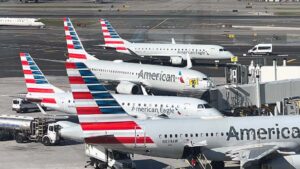
American Airlines, a household name in the aviation industry, boasts a storied history and a prominent position among the world’s largest airlines. Established in 1930, it has grown and evolved, navigating the complexities of the aviation landscape while continually striving to enhance its services and global reach.

American Airlines traces its roots to the Aviation Corporation, which was formed in 1929 as a conglomerate of more than 80 small airlines. In 1930, it was rebranded as American Airways, Inc., and later, in 1934, it adopted the name American Airlines, Inc. The airline’s early growth was marked by the introduction of the DC-3 aircraft in 1936, which revolutionized commercial air travel by offering greater comfort and efficiency.
The post-World War II era was a period of rapid expansion for American Airlines. It introduced the first coast-to-coast service in 1953 and, in 1959, became the first airline to operate the Boeing 707, ushering in the jet age. The 1960s and 1970s saw further growth, with American Airlines pioneering innovations such as the Sabre computerized reservation system, which streamlined booking processes and improved operational efficiency.
The airline industry faced numerous challenges in the 1980s and 1990s, including deregulation, fluctuating fuel prices, and economic downturns. American Airlines navigated these challenges by implementing strategic cost-cutting measures and expanding its route network. In 2001, the airline faced one of its most significant crises following the September 11 terrorist attacks, which had a profound impact on the entire aviation industry. Despite these setbacks, American Airlines demonstrated resilience, focusing on rebuilding and enhancing security measures.
A pivotal moment in American Airlines’ history came in 2013 with its merger with US Airways. This merger created the world’s largest airline in terms of passenger traffic and fleet size, significantly expanding American Airlines’ global reach. The integration process was complex, involving the harmonization of fleets, staff, and operations, but it ultimately strengthened the airline’s competitive position.
American Airlines is also a founding member of the Oneworld Alliance, established in 1999. This alliance brings together several major airlines, enabling them to coordinate services, share resources, and offer passengers seamless travel experiences across multiple carriers. Membership in Oneworld has been a strategic advantage, enhancing American Airlines’ global connectivity.
Today, American Airlines operates a diverse and modern fleet, including aircraft from manufacturers such as Boeing and Airbus. The airline’s commitment to sustainability is evident in its ongoing efforts to modernize its fleet with more fuel-efficient planes, reducing its carbon footprint and environmental impact.
American Airlines’ extensive route network spans over 350 destinations in more than 50 countries, making it a crucial player in international travel. Key hubs such as Dallas/Fort Worth, Charlotte, and Miami serve as vital connecting points, facilitating the efficient movement of passengers and cargo across the globe.
In an industry where customer experience is paramount, American Airlines continually invests in enhancing its services. The airline offers a range of cabin classes, including Flagship First, Flagship Business, and Main Cabin, each designed to cater to different passenger needs and preferences. Premium cabins feature lie-flat seats, gourmet dining, and access to exclusive lounges, ensuring a luxurious travel experience.
American Airlines also embraces technological innovation to improve the passenger experience. The introduction of the American Airlines app allows travelers to manage their bookings, check-in, and receive real-time updates, enhancing convenience and efficiency. In-flight entertainment systems, Wi-Fi connectivity, and personalized service options further contribute to a pleasant journey.
Airlines plane blew a tyre during take-off at Tampa International Airport.
The pilot aborted the take-off and brought the plane to a stop. Emergency vehicles can later be seen arriving at the scene.
A spokesperson for the airport, Joshua Gillin, told local media that everyone on board, including 174 passengers and six crew members, had been “safely deplaned and were bussed to the terminal”.
No injuries were reported, and all passengers were placed on replacement flights to Phoenix.